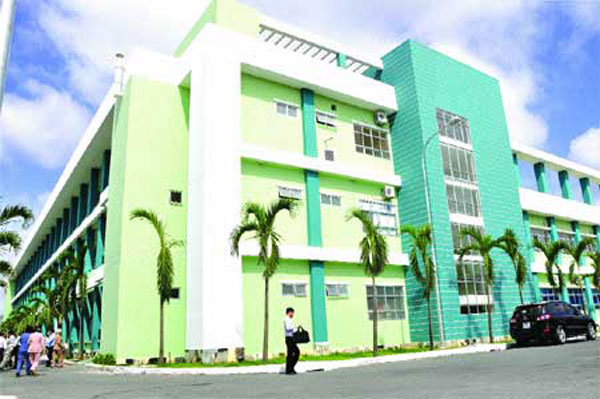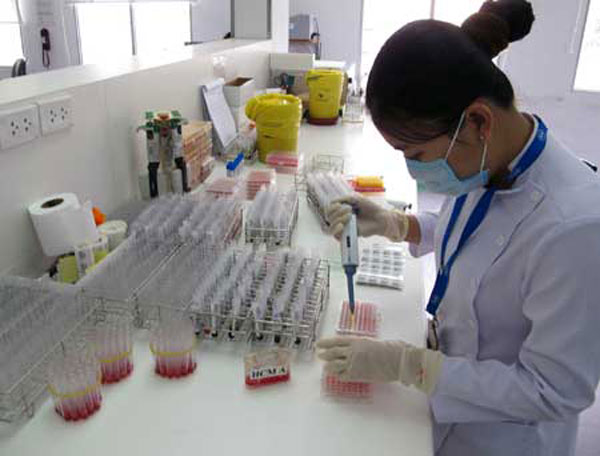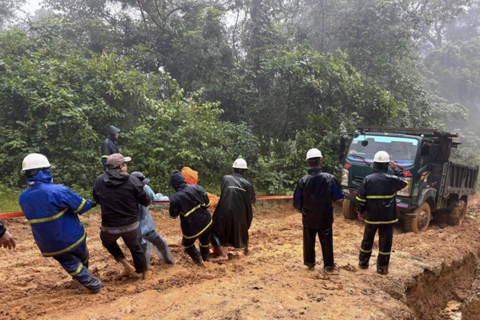HCM City a magnet for medical tourists
The growing reputation of Vietnamese doctors has led to a boom in foreigners seeking treatment here, and locals who once went abroad are also opting for healthcare at home.
 |
|
Timely response: The construction of Binh Tan Hospital in 2011 was funded by the HCM City People's Committee to meet demand in Binh Tan as well as neighbouring districts. |
Last year, a Filipino couple who found it difficult to conceive after two failed fertility treatments decided to seek medical help in Viet Nam, having heard about the reputation of local physicians.
The woman and her husband, who works in the Mekong Delta city of Can Tho, visited a HCM City hospital where doctors recommended them to choose in vitro fertilization (IVF).
"We discussed it and thought we would try it in Viet Nam," the woman said, adding that they had usually sought medical treatment in their home country.
After the initial doctor's visit, the woman, who declined to be named, discovered that Vietnamese obstetrician Vuong Thi Ngoc Lan was internationally known, and that costs were lower than in many other countries.
She then visited Dr Lan, who was working at HCM City's My Duc Hospital at the time.
"She said that we had a 40 per cent chance, and luckily, with one IVF cycle, we were successful," the woman said.
 |
|
|
See through: A patient undergoes a CTscan at the People's Hospital 115 in HCM City's District 10. See through: A patient undergoes a CTscan at the People's Hospital 115 in HCM City's District 10. |
Along with reproductive medicine, other medical treatments like organ transplants and cardiovascular and eye surgeries have also brought international recognition to Viet Nam, according to Tran Quy Tuong, deputy head of the Ministry of Health's Disease Treatment Management Department.
Speaking at a recent healthcare conference in HCM City, Tuong noted that Viet Nam's use of more advanced medical modalities had helped attract a growing number of foreign and local patients.
Of all the fields, more foreign patients visit Viet Nam for fertility treatment than any other kind of care, according to Dr Ho Manh Tuong, head of An Sinh Hospital's IVF Ward.
The professional skills of Vietnamese doctors in this field are at the same level or even higher than their colleagues elsewhere.
Hospitals in Viet Nam have also given investment priority to the purchase of state-of-the-art equipment for reproductive medicine including IVF.
Apart from high professional skills, the costs for IVF and other medical treatments are lower in Viet Nam than in many other countries, and many Vietnamese doctors, who have studied abroad, can communicate in English.
Dr Tuong said referrals from foreign doctors attending international conferences with their Vietnamese counterparts had also contributed to the increasing number of foreign patients.
Over the last few years, about 300 foreigners visited the country annually for IVF treatment, he estimated.
Dr Hoang Thi Diem Tuyet, deputy head of Tu Du Obstetrics Hospital in HCM City, said her hospital had also seen an increasing number of foreigners seeking fertility treatment.
"Our hospital's success rate is around 45 per cent, the same as other countries in the region," she added.
 |
|
Top notch: With state-of-the-start equipment for health exams and treatment, District 2 Hospital in HCM City has won the trust of residents. It has also helped reduce patient overload at central and state hospitals. |
The price of one cycle of IVF at the hospital was US$2,000-2,500, while in Singapore and Thailand the cost would be more than $10,000, Tuyet said.
Through the hospital's IVF-Ward website, foreign patients can schedule appointments with doctors. When a woman arrives, her ovaries are stimulated, and 10 to 12 days later the eggs are removed and fertilised with the husband's sperm. The zygote is cultured for two to five days in a growth medium and then implanted in the uterus.
Dr Tuong of An Sinh Hospital said even more foreigners were expected to visit Viet Nam after a new decree takes effect early this year that would allow the use of eggs and sperm from Vietnamese donors.
Eye, cardiovascular surgeries
Along with recognition for its success in IVF, Viet Nam is also becoming known for its success in eye and cardiovascular surgery.
Dr Tran Hai Yen, deputy director of HCM City Eye Hospital, said many foreign patients from Europe, North America, Australia, Singapore and other countries seek refractive surgery procedures at the hospital because of low costs and high-quality treatment.
 |
|
Vital fluid: A lab technician works at the HCM City Blood Transfusion-Hematology Hospital, the leading hospital in the country for stem-cell transplants. |
Last year, 41 foreign patients visited the hospital for eye-laser surgery, she said.
"Unlike the past, the skills of Viet Nam's doctors have improved, and they are confident in their ability to perform surgery on patients from the US or Europe," said Dr Nguyen Huu Chuc, head of Cho Ray Hospital's Eye Ward.
He said that Vietnamese surgeons' skills were equal to foreign ones.
Moreover, advanced technologies in eye treatment are used at the HCM City Eye Hospital and at other eye hospitals in the country.
As many foreign patients are aware of the surgeons' reputations, they also visit Viet Nam for cataract surgery and refractive error treatments.
"Many foreigners working in Viet Nam also choose to stay here for treatment," he added.
Apart from its better-known treatments in reproductive medicine and eye surgery, Viet Nam has also been successful in performing more common surgeries.
In June last year, for example, a 56-year-old American man who works in HCM City visited Cho Ray Hospital after suffering a tear in his Achilles tendon.
Le Thi Giau, the man's wife, said friends and relatives advised them to return to the US for "better treatment", but she encouraged him to go to Cho Ray as she trusted the doctors' expertise.
"Now, my husband can walk," she added.
 |
|
Under the knife: Doctors at perform heart surgery on a child at the HCM City Medical University. |
After two months of surgical treatments at Cho Ray, the couple visited the US where doctors told them that the "Vietnamese doctors had done well," Giau said.
At Cho Ray, the man's treatment cost $1,000, compared to about $15,000 in the US, she added.
In the cardiovascular field, local doctors have also gained a high level of expertise, and foreign doctors often visit Viet Nam to learn from them.
On November 29 last year, Cho Ray Hospital's cardiovascular unit treated a 58-year-old Japanese patient who had a sudden acute type-B aortic dissection, a life-threatening condition with a high mortality rate.
"Early intervention for patients is very vital," said Dr Nguyen Thai An, head of the cardiovascular ward.
The doctor and his colleagues placed a stent graft to redirect blood flow and stop pressure on the weak aortic wall.
"The man recovered, and there have been no complications," Dr An said, adding that the hospital had performed similar surgery on 60 patients since 2012.
According to the hospital's figures, 1,200 foreign patients were treated at Cho Ray Hospital in 2014. One-fourth of them were from the US, France, Australia and Japan. The remaining were citizens of developing countries.
Cambodians represented the highest number of foreign patients from the developing countries, treated in HCM City, with 885 treated at Cho Ray last year.
Apart from Cho Ray Hospital, Cambodians have also sought treatment at the University of Medicine and Pharmacy and Sai Gon International Traumatology and Orthopedics Hospital.
The Cambodian patients cite ease of travel, low costs and quality care as reasons for seeking medical care in Viet Nam.
A 48-year-old patient from Phnom Penh, whose femur was broken, said she was more confident that Vietnamese doctors could give her better treatment. She is now recovering from a successful hip replacement.
Another Cambodian woman, Chinda, who is of Vietnamese origin, said she often brought her children or relatives to Viet Nam for treatment.
Service challenges
Although more treatment of foreigners has occurred in recent years, Dr Tuong of An Sinh Hospital said there were still challenges as foreigners complain about a dual pricing system at public hospitals, one for Vietnamese and the other for foreigners.
Dr Yen, deputy director of the Eye Hospital, said: "Foreign patients are not happy with this price policy because they think it is unfair."
Foreigners pay higher fees, but many healthcare staff cannot satisfy their standards because of poor language skills, inadequate patient-care services and a lack of professionalism, as well as overcrowded hospitals and clinics, she added.
In addition, foreign patients have a habit of paying with credit cards, while local hospitals, especially public ones, only accept cash.
At a recent kick-off ceremony for HCM City's third Paediatrics Hospital, Prime Minister Nguyen Tan Dung urged local authorities, especially large cities such as HCM City and Ha Noi, to speed up construction of city branches of Cho Ray Hospital, Oncology Hospital and Orthopedic Trauma Hospital.
Huynh Cong Hung, head of the HCM City People's Council's Committee for Cultural and Social Affairs, said Vietnamese doctors were increasingly studying abroad and reaching international standards in many fields.
Such standards and credentials also facilitated payments from health insurance companies, he added.
Of HCM City's three medical schools, two of them, HCM City Medical University and Viet Nam National University of HCM City's Medical School, partner with foreign universities who send medical instructors for short-term training.
However, the Pham Ngoc Thach University of Medicine in the city has full-time professors from the Johannes Gutenberg Mainz University who teach classes at the university's Viet-Duc (Viet Nam - Germany) Medical Ward, established in 2013 to train students in European standards.
Hung said that the city would encourage more cooperative programmes at medical universities to further enhance the growing reputation of Viet Nam's medical professionals.








